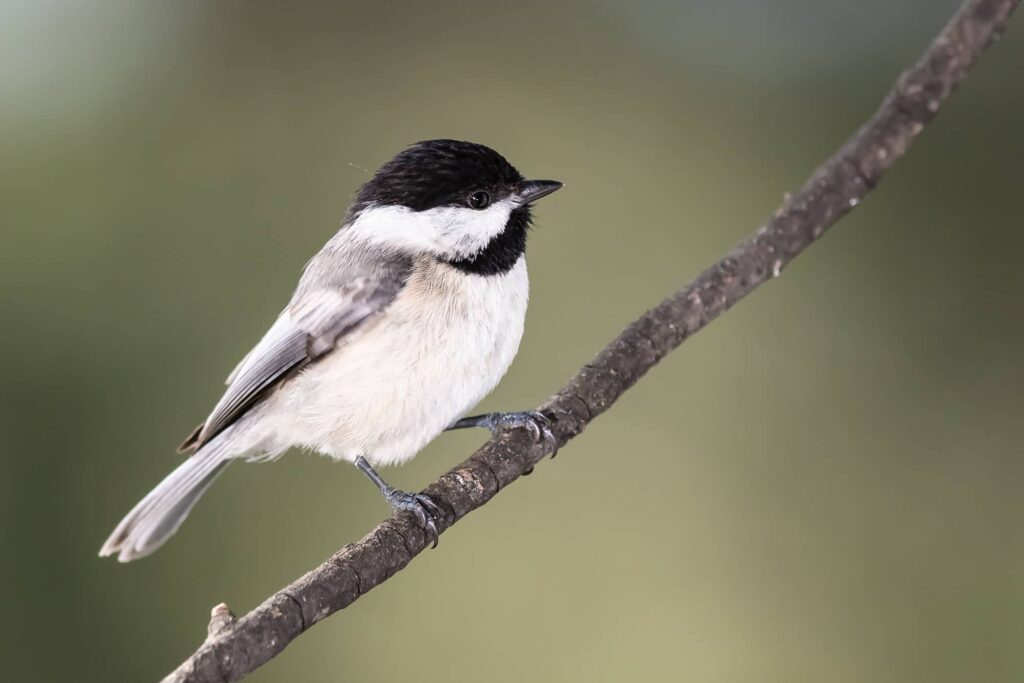Although known for its clear beaches, jaw-dropping historic districts, and miles-wide golf courses, South Carolina doesn’t disappoint with its ample birdlife.
There are precisely 437 species of birds in South Carolina, with some appearing with over 60% frequency year-round.
If you’re planning to go bird watching in the Palmetto State, keep your eyes peeled for the stunning species below!
Red Birds in South Carolina
Pine Grosbeak
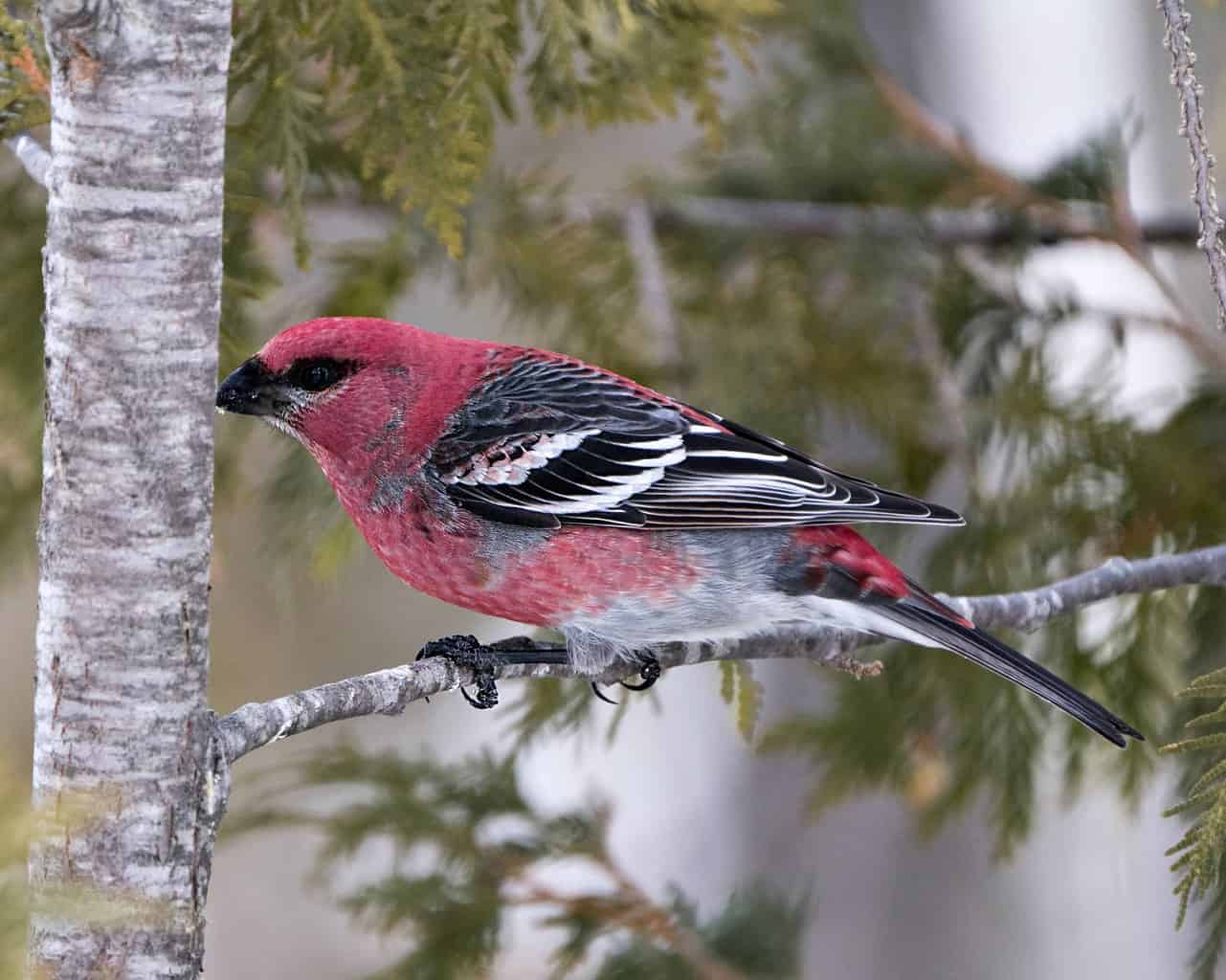
- Scientific Name: Pinicola enucleator
- Length: 9 to 10 inches
- Weight: 1.8 to 2.8 ounces
- Wingspan: 12 to 13 inches
Pine Grosbeaks are one of the largest finch species in South Carolina. Although large compared to other finches, they’re often absurdly tame; so much so that they’re easily overlooked in dense, coniferous forests.
Male Pine Grosbeaks are reddish-pink with grayish wings marked by twin white wing bars. Females and immature birds are less conspicuous, with primarily gray bodies with almost unnoticeable tints of reddish-orange on their heads and rumps.
Unlike most finches, Pine Grosbeaks mainly feed on seeds, berries, buds, vegetable matter, etc. For this reason, they’re often seen visiting backyard bird feeders and large hoppers.
Red-headed Woodpecker

- Scientific Name: Melanerpes erythrocephalus
- Length: 8.2 to 9.8 inches
- Weight: 5 ounces
- Wingspan: 13 to 14.5 inches
With striking patterns and loud, harsh calls, Red-headed Woodpeckers are one of the easiest birds to spot in South Carolina. They’re quite the sight to behold with their signature bright-red heads, white wings and bellies, and black backs.
Red-headed Woodpeckers are primarily seen in open forests, particularly in clear understories like standing timber and pine forests. Since they’re quite social, they often sally out to catch insects in family groups.
As they’re opportunistic feeders, Red-headed Woodpeckers are often labeled as the most omnivorous of all woodpeckers.
Their diets consist of a wide variety of foods, including insects, berries, seeds, wild and cultivated fruit, and, although rarely, small rodents. If they’re desperate enough, they’ll also eat eggs and nestlings of other birds, as well as bark pulled from tree trunks.
White-Winged Crossbill
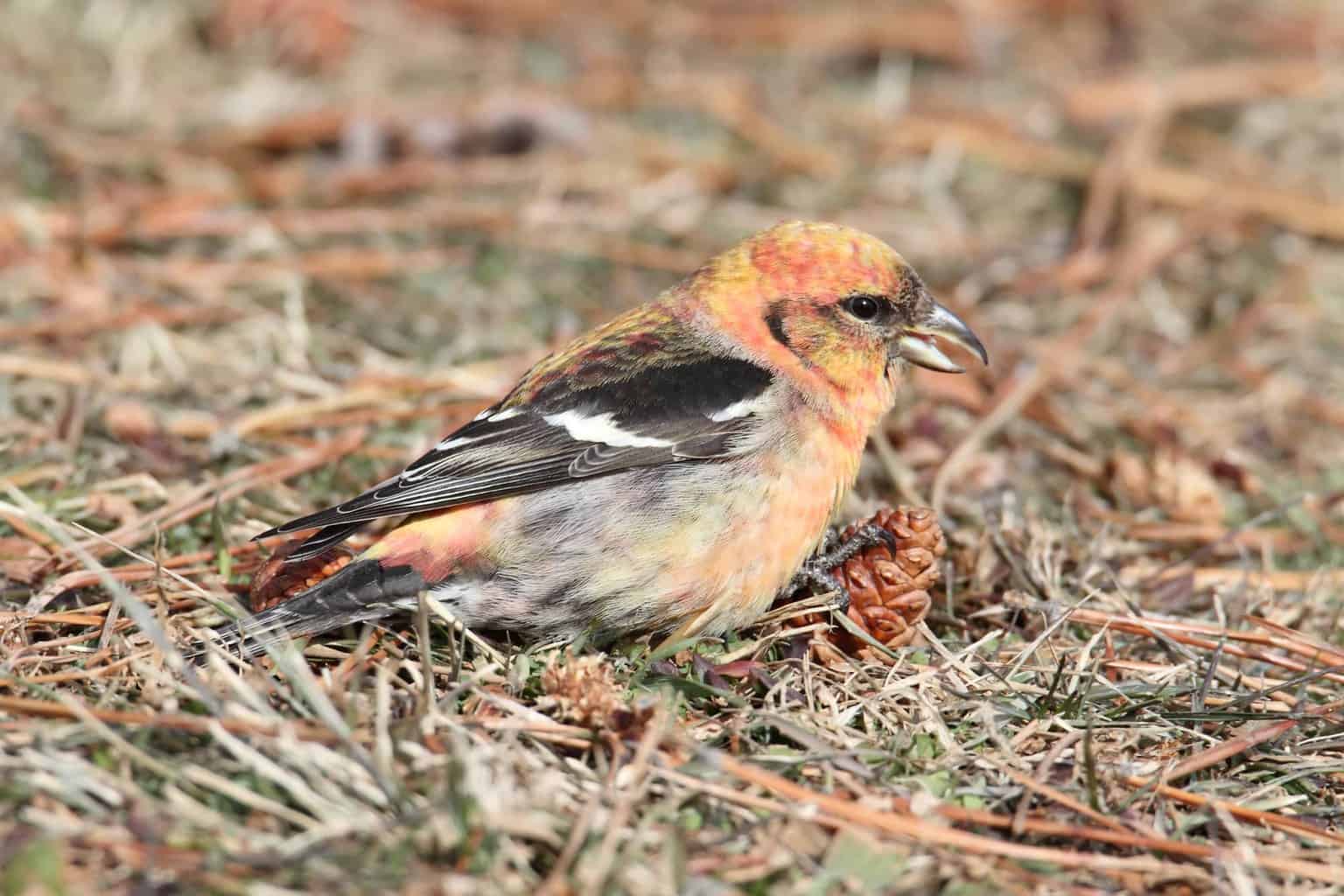
- Scientific Name: Loxia leucoptera
- Length: 5.9-6.7 in
- Weight: 0.8 to 0.9 ounces
- Wingspan: 10.2 to 11.0 inches
Despite what the name suggests, White-winged Crossbills aren’t predominantly white; their wings aren’t even white—not entirely, at least.
Male and female White-winged Crossbills significantly differ in appearance. Males are bright rose-pink with a black tail, while females are yellowish with streaked bellies and backs.
In South Carolina, White-winged Crossbills are found in flocks all year-round, even during nesting season. They forage primarily in tamarack and spruce, with their peculiar crossed bills prying open spruce cones to eat the seeds.
Northern Cardinal
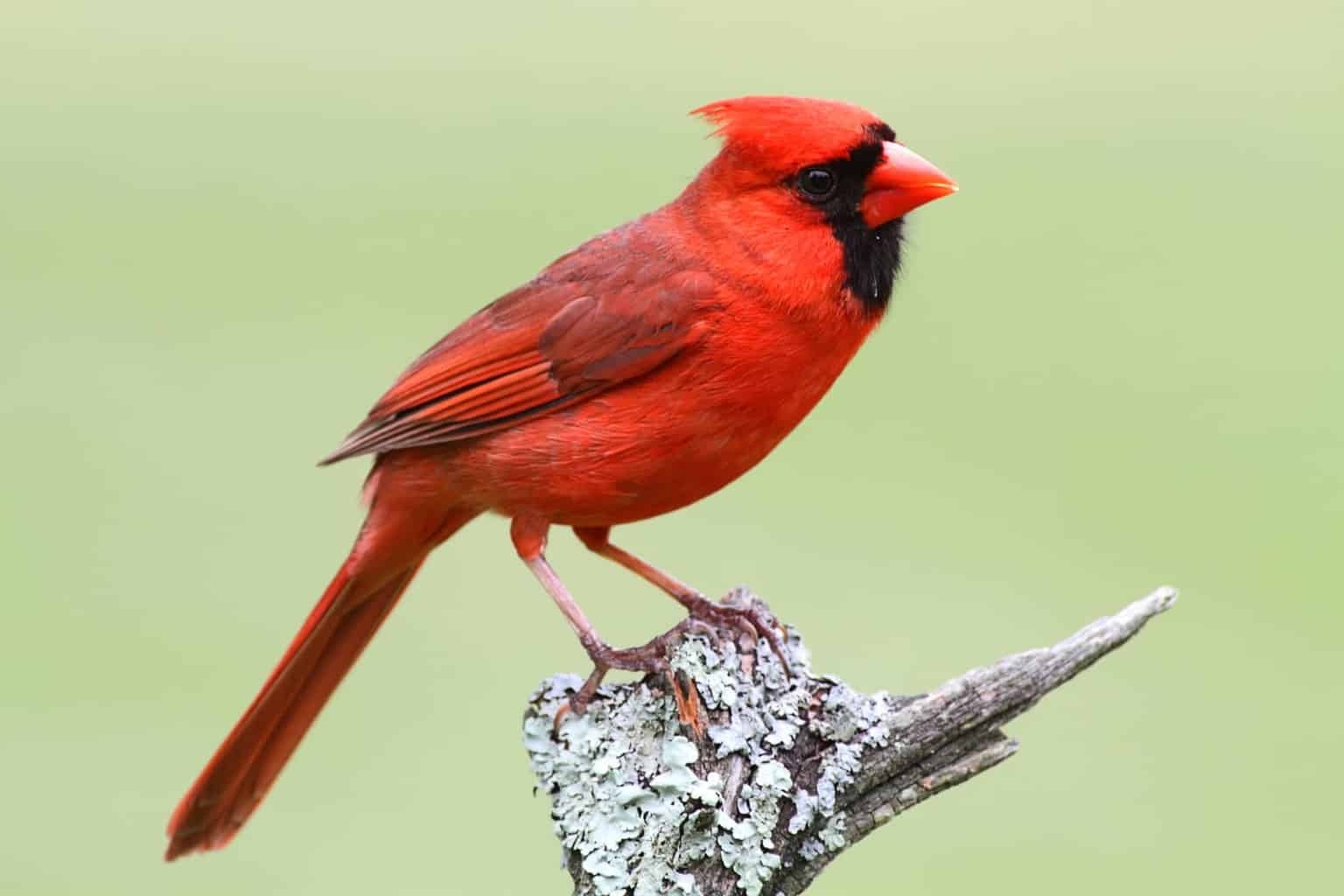
- Scientific Name: Cardinalis cardinalis
- Length: 8.3 to 9.1 inches
- Weight: 1.5 to 1.7 ounces
- Wingspan: 8.9 to 12.2 inches
Suave-looking and regal in appearance, Northern Cardinals are a perfect combination of familiarity and style. They’re arguably the most common and favorite bird species in South Carolina, appearing with 60% frequency throughout all seasons.
Male Northern Cardinals are striking red all over, from their glorious red crests to the tip of their tails. While not as brightly colored, female Northern Cardinals are equally charming with their soft brown plumage and faintly reddish wings.
Although they’re often seen in forest and woodland edges, you can also spot Northern Cardinals in cities, towns, and suburban gardens. Although somewhat elusive, they are common feeder birds.
House Finch
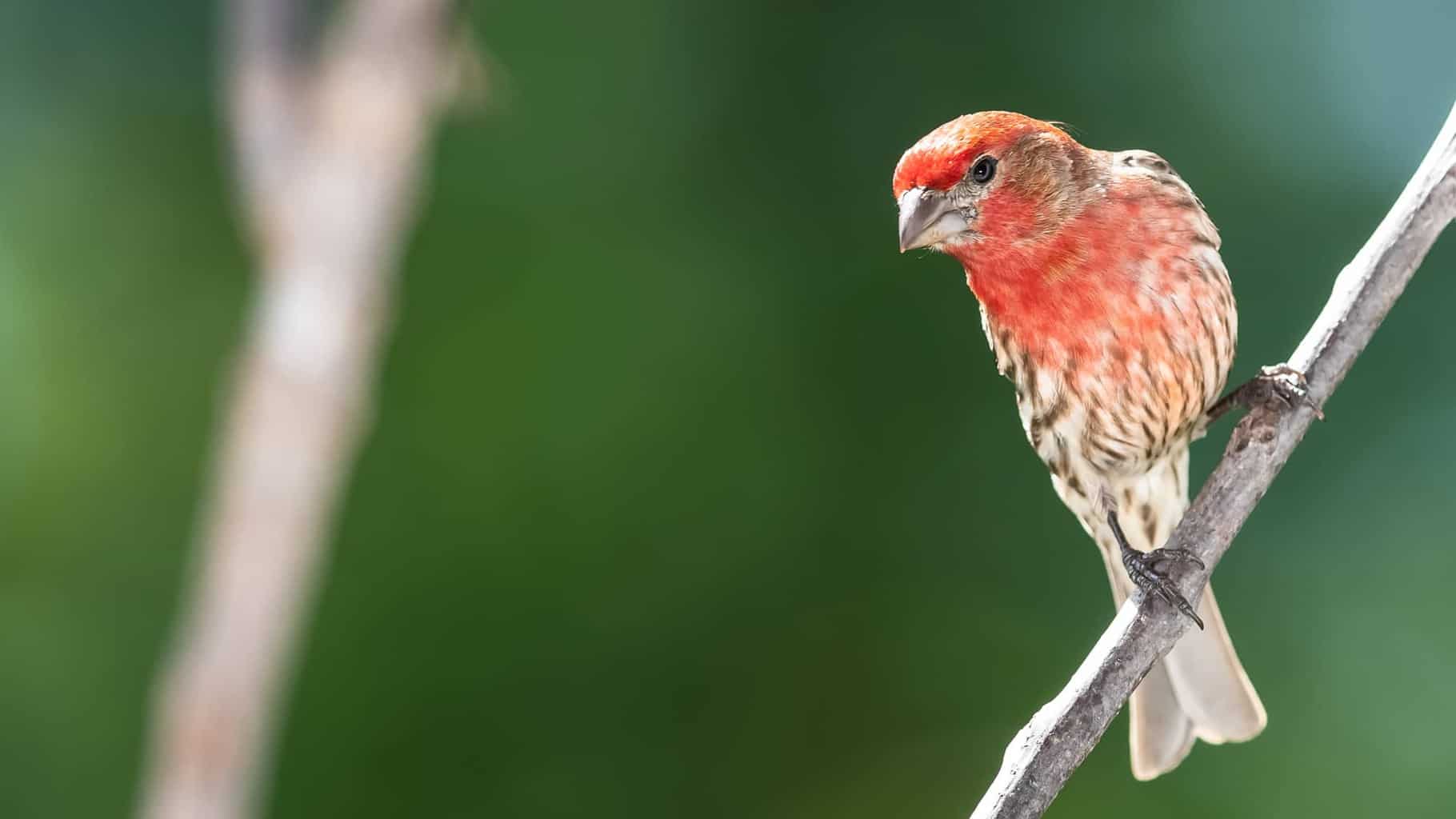
- Scientific Name: Haemorhous mexicanus
- Length: 4.9 to 6.1 inches
- Weight: 0.6 to 0.9 ounces
- Wingspan: 8.1 to 10.5 inches
House Finches are among the most common birds in South Carolina and are easily recognized by their conical seed-eating bills and plump, rosy-red plumage. They’re familiar visitors to backyard feeders and frequent city parks, urban centers, farms, and forest edges.
House Finches are primarily vegetarians, feeding on seeds, berries, buds, and vegetable matter.
Young House Finches feed on regurgitated seeds. They’ll settle on small insects like aphids if food sources are scarce.
These gregarious common backyard birds flock in numbers on nearby trees, weed stalks, and feeders, and their twittering songs are heard in most South Carolinian neighborhoods.
Scarlet Tanager
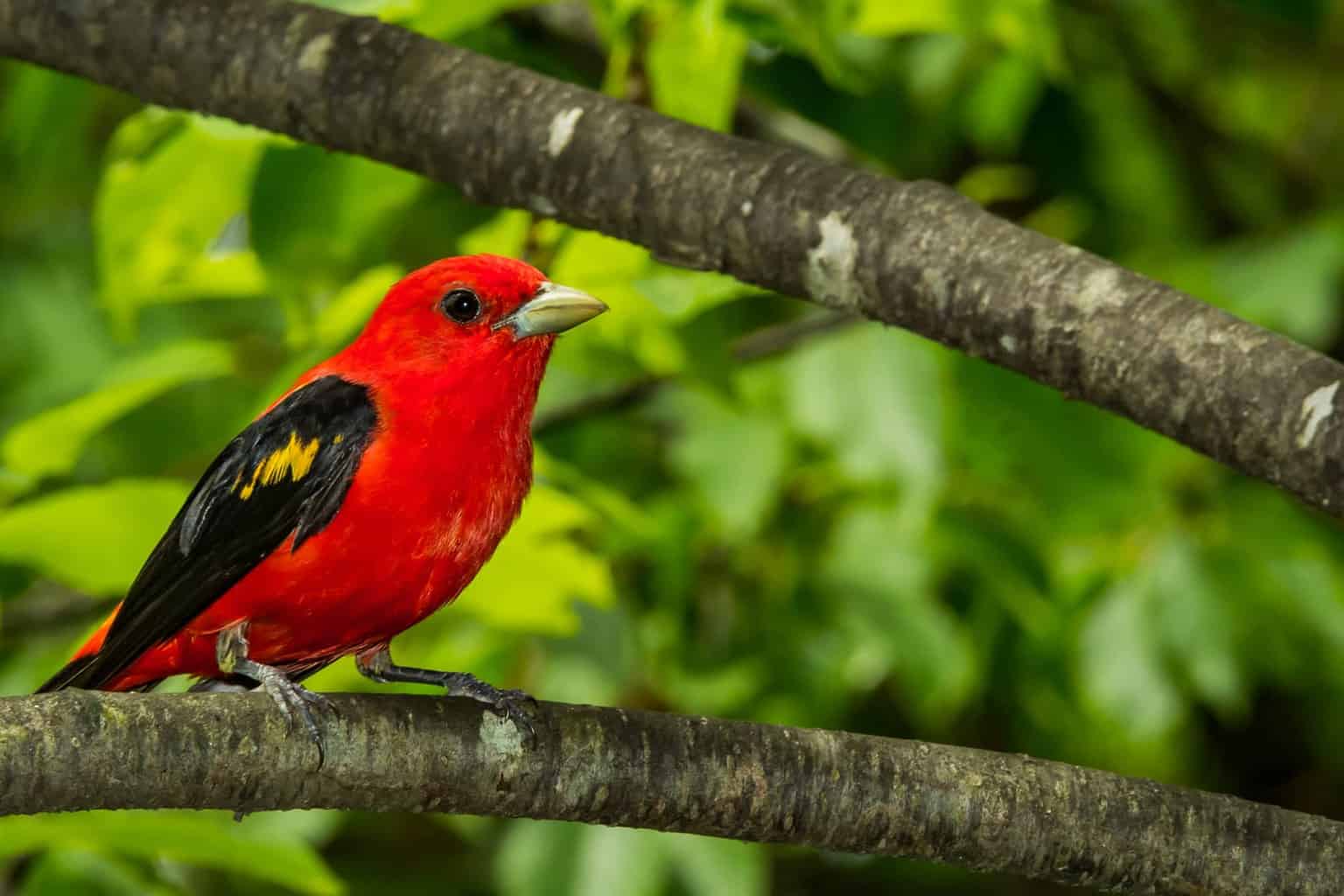
- Scientific Name: Piranga olivacea
- Length: 6.3 to 6.7 inches
- Weight: 0.8 to 1.3 ounces
- Wingspan: 9.8 to 11.4 inches
Noted for their brilliant plumage, Scarlet Tanagers are medium-sized songbirds with blood-red bodies set off by their jet-black forked tail and wings.
Although fairly common in South Carolina’s oak forests, they’re frustratingly hard to find as they often remain out of sight.
During summer, Scarlet Tanagers are primarily insectivorous, feeding on insects like beetles, wasps, caterpillars, and some spiders. They also eat berries, particularly raspberries, blackberries, juneberries, and strawberries.
Scarlet Tanagers spend most of their time in forest canopies, stalking among the leaves of deciduous trees. Once in a while, they’ll visit feeders in the spring, usually after periods of cold or rainy weather.
Summer Tanagers
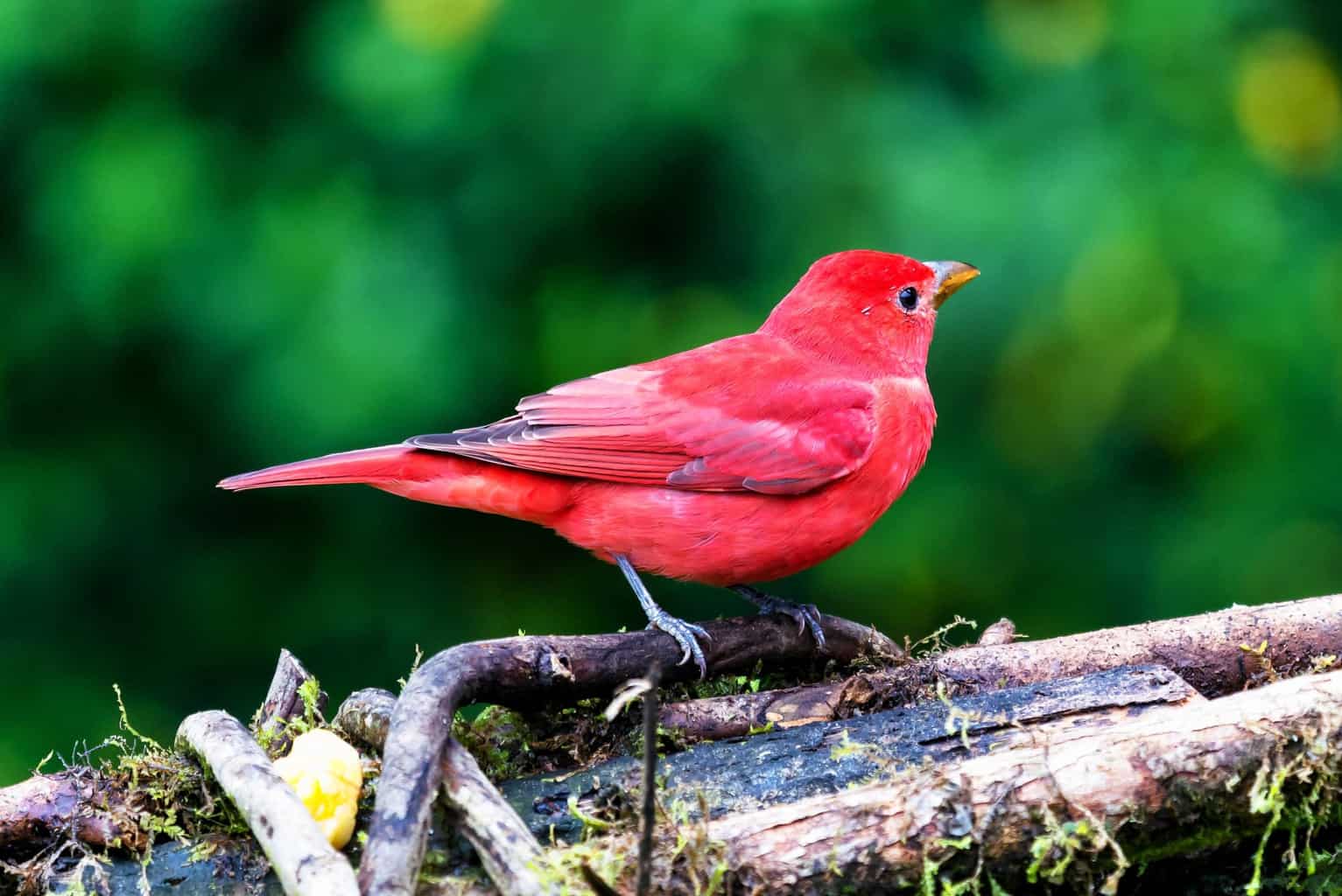
- Scientific Name: Piranga rubra
- Length: 6.7 inches
- Weight: 1.1 ounces
- Wingspan: 11 to 12 inches
Eye-catching sights against green leaves and thick canopies, Summer Tanagers are the only entirely red bird species in South Carolina and all of North America. They have blood-red feathers, blunt-tipped bills, and medium-sized bodies.
These songbirds are typically found in high forest canopies. They’re fairly common in South Carolina and mostly seen during the summer.
Summer Tanagers specialize in catching wasps and bees on the wing, expertly avoiding painful stings as they catch them mid-air. Apart from insects, they occasionally indulge in berries and small fruits.
Vermilion Flycatcher
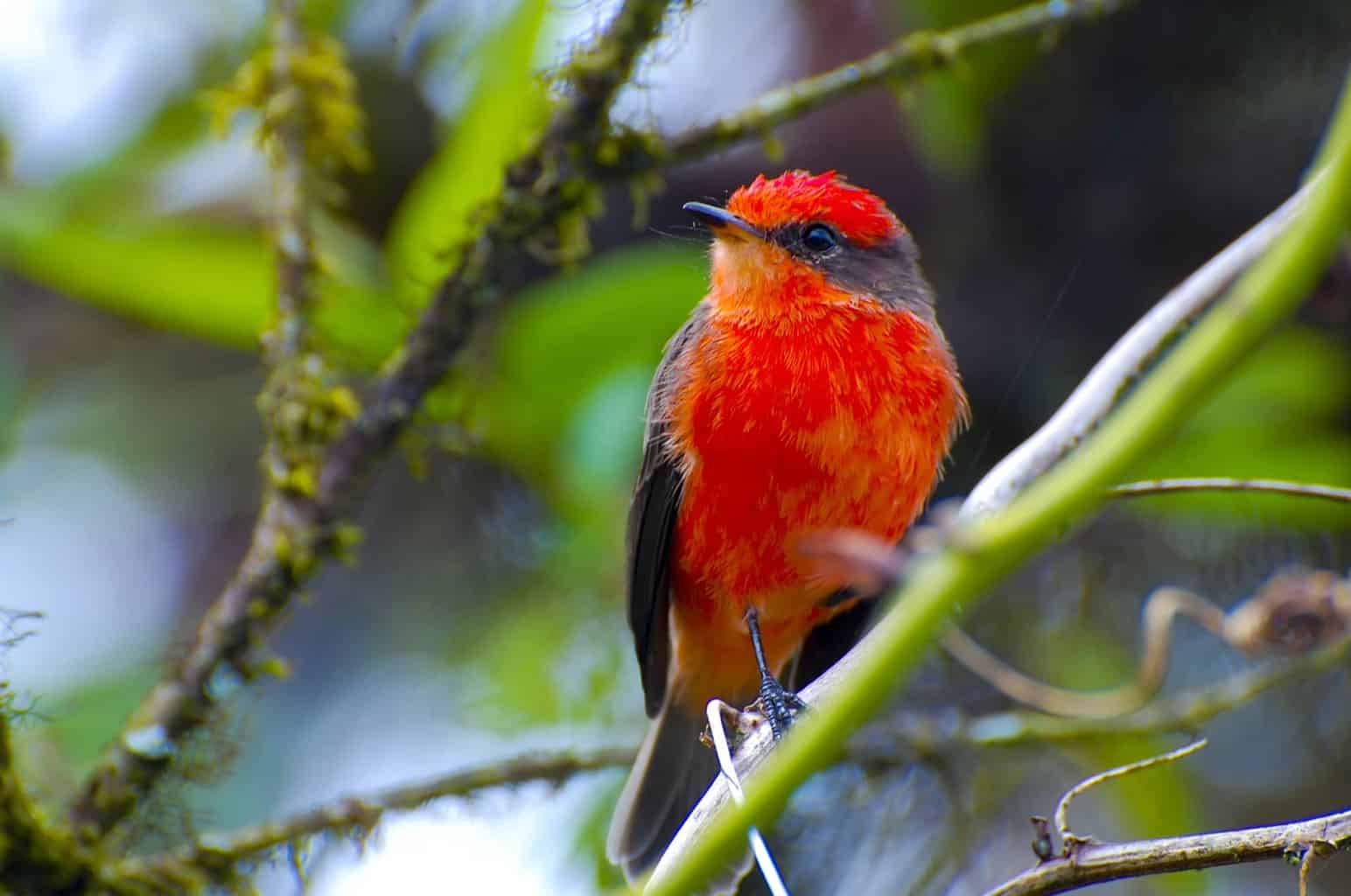
- Scientific Name: Pyrocephalus rubinus
- Length: 5.1 to 5.5 inches
- Weight: 0.4 to 0.5 ounces
- Wingspan: 9.4 to 9.8 inches
Small, plump, and utterly adorable, Vermilion Flycatchers are brilliant red birds usually seen perched low in broad, open areas, particularly those near water, including stream sides in savannas, ranches, and arid country.
Although they’re year-round residents in South Carolina, Vermilion Flycatchers aren’t the most common flycatcher birds in the state. Even so, their bright red feathers make them easy to spot, even miles away.
Blue Birds in South Carolina
Lazuli Bunting
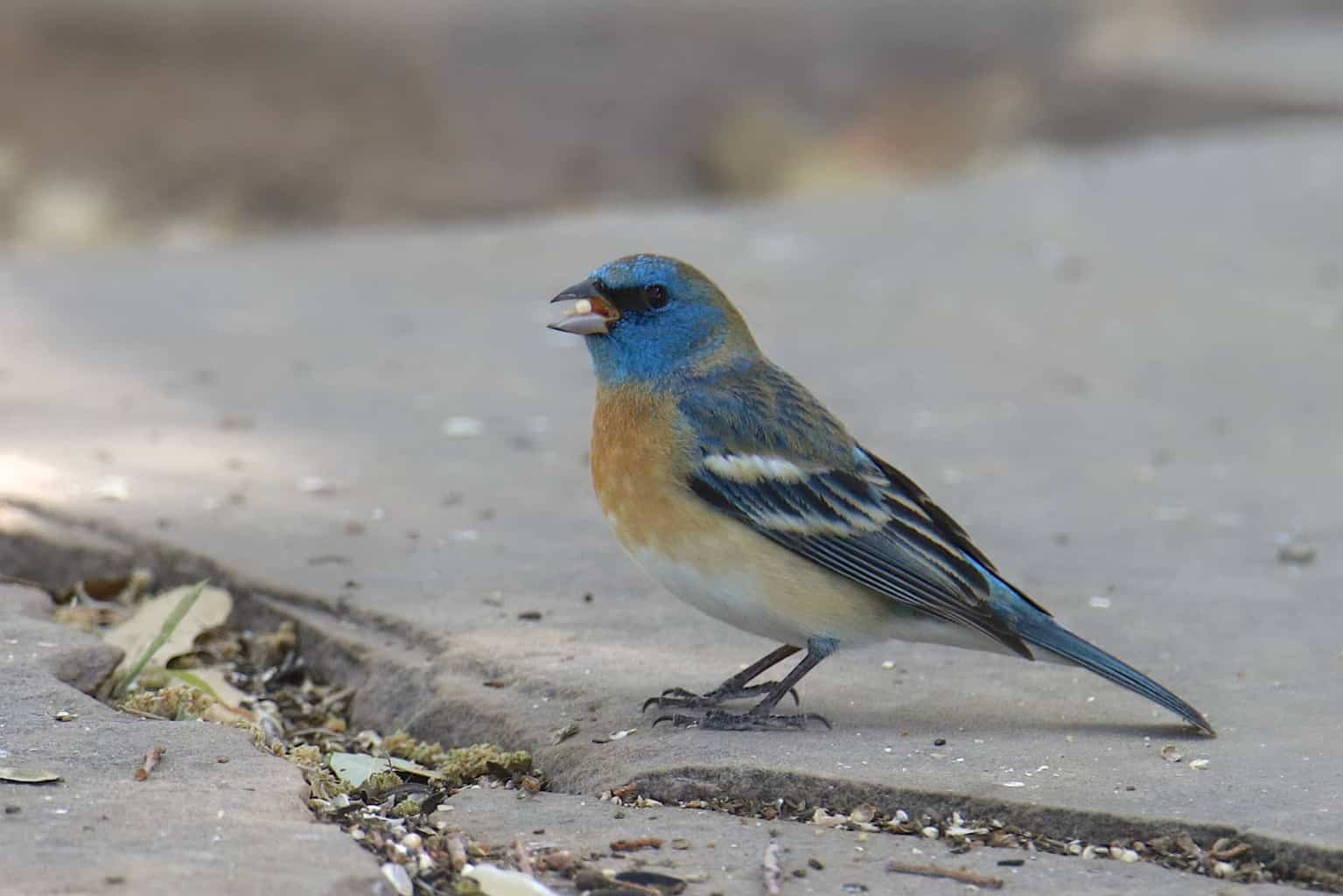
- Scientific Name: Passerina amoena
- Length: 5.1 to 5.9 inches
- Weight: 0.5 to 0.6 ounces
- Wingspan: 8.7 inches
South Carolina’s beautiful summers bring many birds to the state, including the brightly-colored Lazuli Buntings.
Lazuli Buntings are small, stocky songbirds with astonishingly cerulean upperparts, bold white bellies, and orange breasts.
Females aren’t as boldly patterned, with their grayish-brown upperparts and bluish wings and tails. They can be challenging to distinguish from Indigo Buntings because of their strikingly similar colorings.
Often found in open brush and streamside shrubs, Lazuli Buntings primarily feed on insects, seeds, and grain. They also frequent bird feeders, especially ones that generously offer black oil sunflower seeds, nyjer thistle seeds, and white proso millet.
Eastern Bluebird
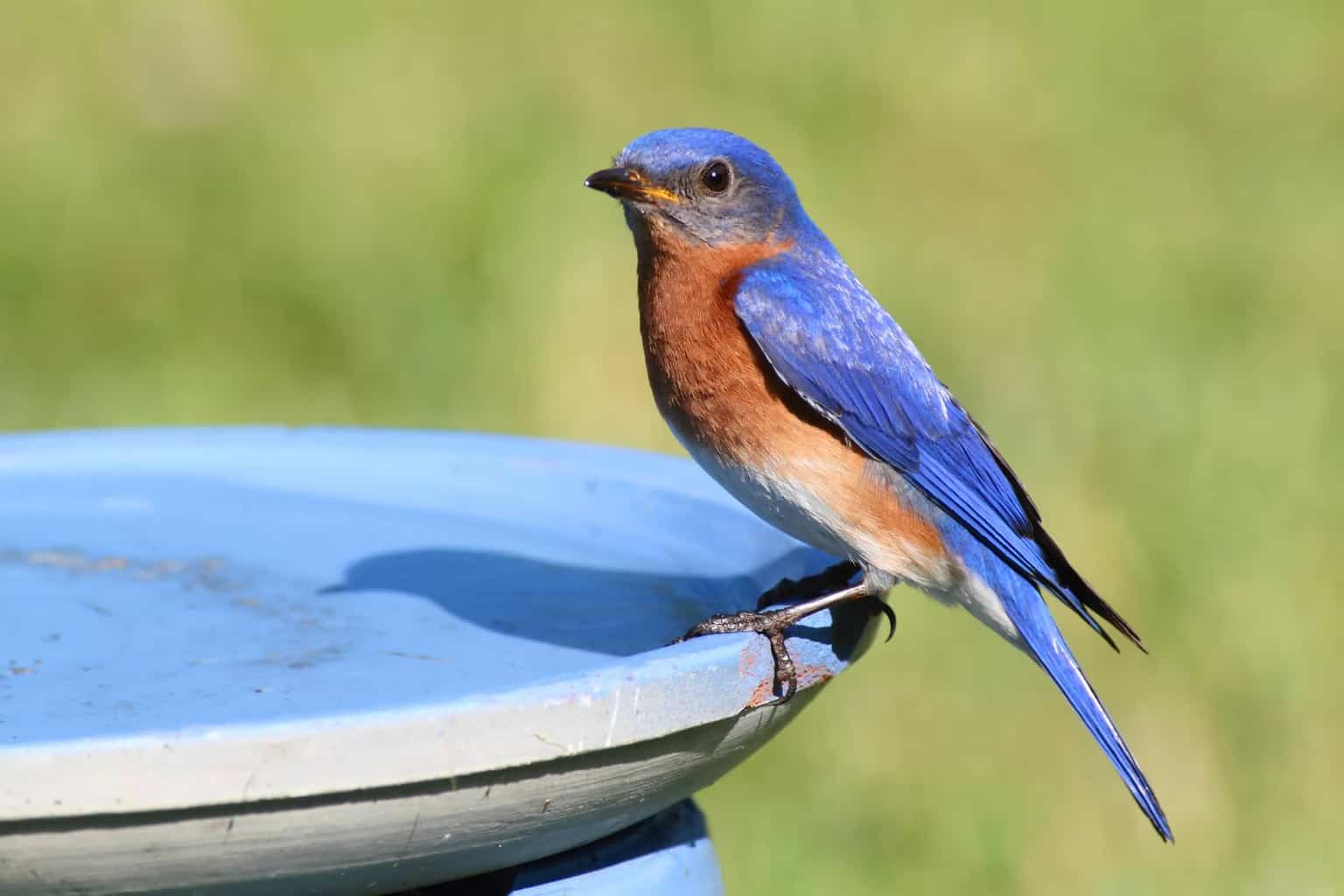
- Scientific Name: Sialia sialis
- Length: 6.3 to 8.3 inches
- Weight: 0.9 to 1.2 ounces
- Wingspan: 9.8 to 12.6 inches
Eastern Bluebirds are the most common among all three known bluebirds in South Carolina. The majority nest in birdhouses put up especially for them along bluebird trails.
Male Eastern Bluebirds flaunt royal blue upperparts, white bellies, and bright orange breasts and throats. Females have duller colors overall; grayish above with bluish wings and tail, and faintly orange-brown breasts.
These birds favor open fields with scattered trees and semi-open habitats like forest clearings, cut-over or burned areas, and suburbs with extensive lawns.
Blue Jay
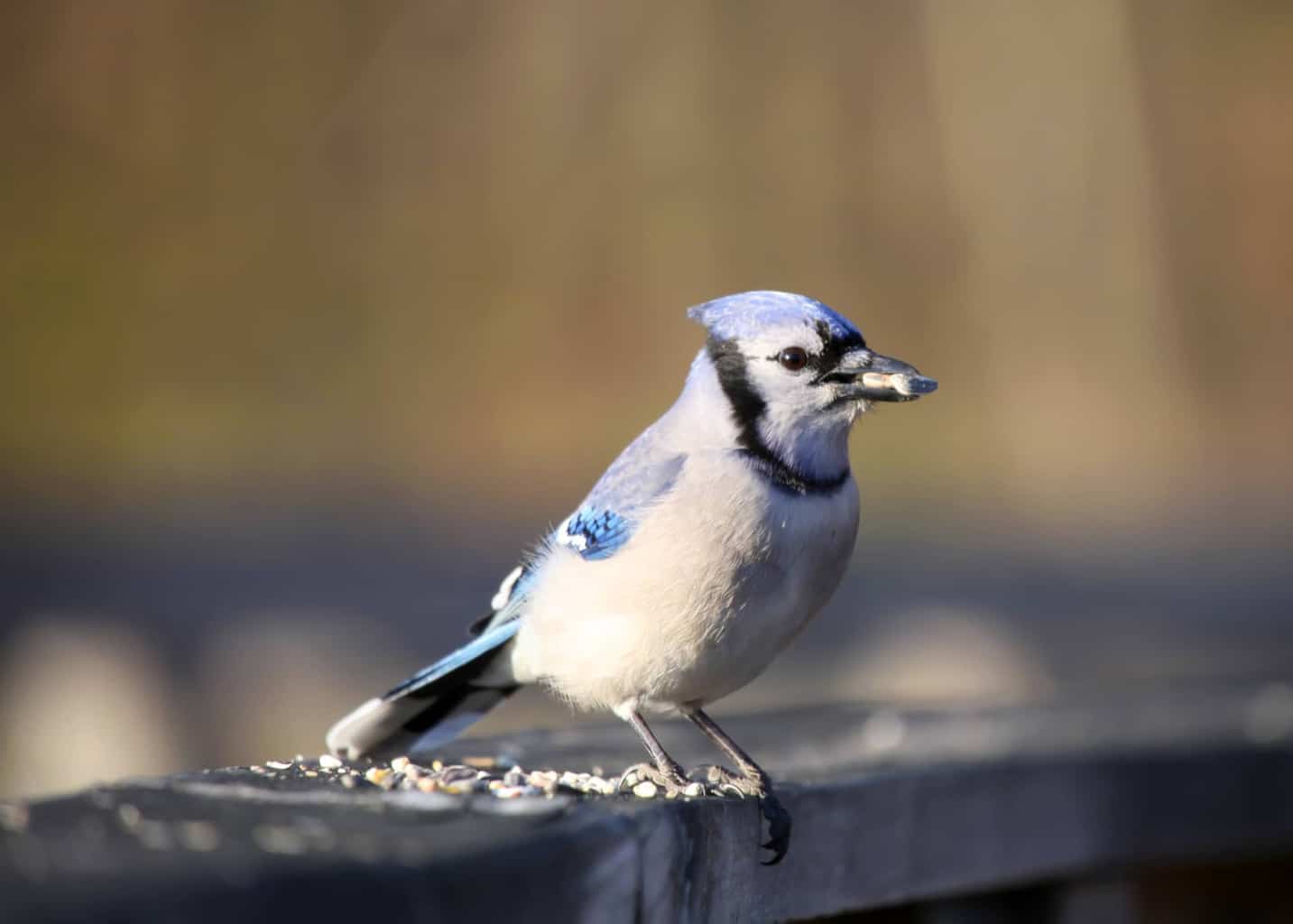
- Scientific Name: Cyanocitta cristata
- Length: 8.6 to 11.8 inches
- Weight: 2.5 to 3.5 ounces
- Wingspan: 13.3 to 16.9 inches
Blue Jays are one of the loudest and most colorful songbirds in South Carolina. They’re unmistakable with their perky crests and tri-colored white, black, and blue feathers.
Blue Jays are common habitants of forest edges and are often found near oaks, woodlots, towns, parks, and cities. They rarely visit purely coniferous forests, opting for mixed or deciduous woods.
Apart from their raucous “Jay! Jay!” calls, these birds are known to make a variety of musical sounds. Additionally, they frequently mimic the calls of hawks, particularly Red-shouldered Hawks.
Blue Jays mainly eat insects, nuts, and vegetable matter. If desperate, they’d also eat eggs and nestlings of other birds.
Blue-Throated Mountain-Gem

- Scientific Name: Lampornis clemenciae
- Length: 4.5 to 4.9 inches
- Weight: 0.3 ounces
- Wingspan: 2.7 to 3 inches
Also known as Blue-throated Hummingbirds, Blue-throated Mountain-gems are relatively large hummingbirds with long, slightly decurved bills. They’re named for their sparking blue throats.
Blue-throated Mountain-gems mostly eat nectar from flowers and hummingbird feeders. They’re very possessive of their favorite food sources and will often chase smaller hummingbirds away to keep the nectar to themselves.
These birds mostly live in coniferous and mixed woodlands, particularly those with elevations between 3,200 to 11,500 feet.
Green Birds in South Carolina
Buff-Bellied Hummingbird
- Scientific Name: Amazilia yucatanensis
- Length: 3.9 to 4.3 inches
- Weight: 0.14 to 0.18 ounces
- Wingspan: 5.75 to 6 inches
Although this small-sized bird regularly nests in southernmost Texas, Buff-bellied Hummingbirds occasionally visit South Carolina during spring and summer.
As the name suggests, Buff-bellied Hummingbirds have buff-colored bellies along with their iridescent green throats, rusty tails, and dark wings.
They’re often found in various shrubby or wooded habitats, especially those with plenty of flowers. They also visit hummingbird feeders, although not as often as other hummingbird species in South Carolina.
Green-Breasted Mango
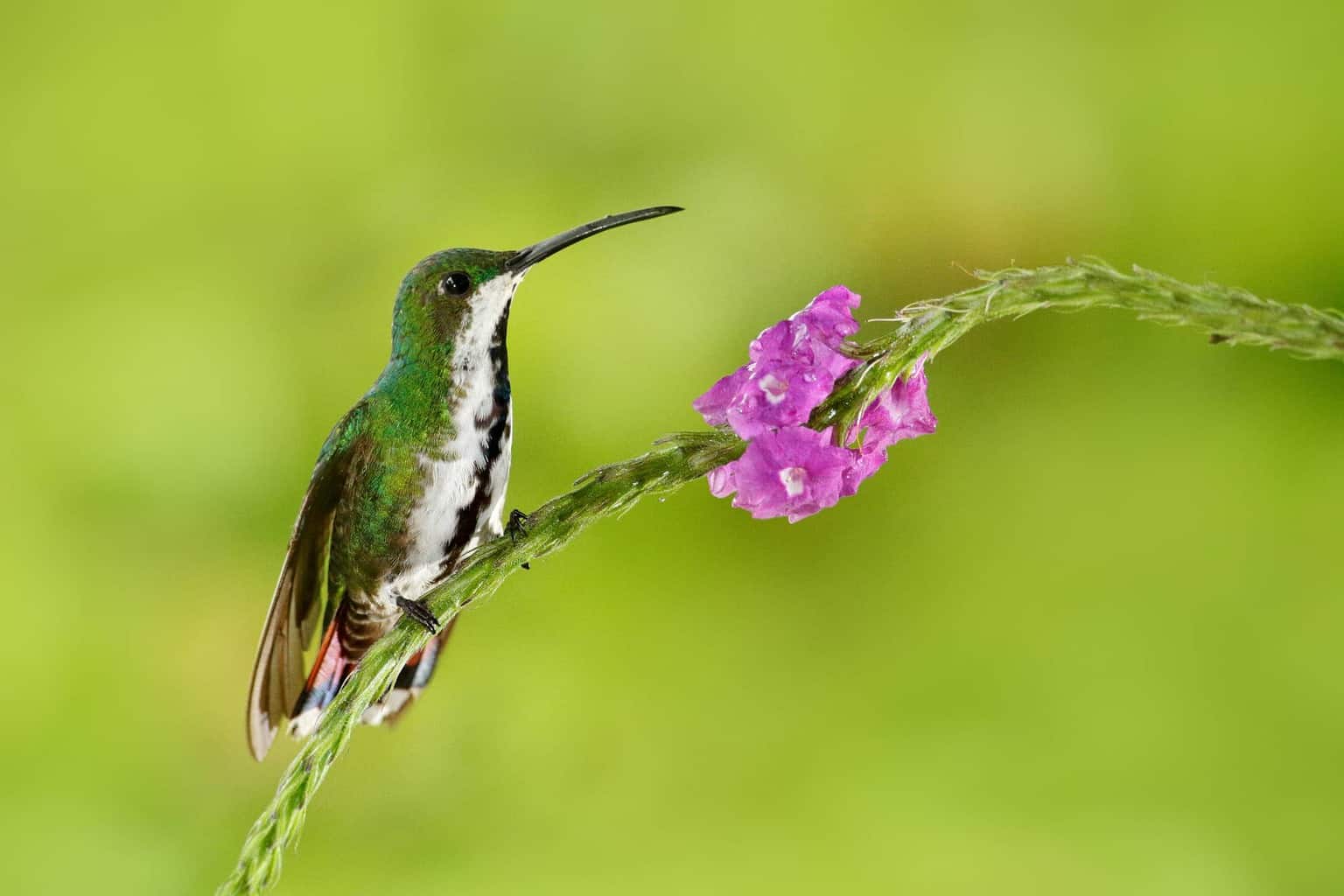
- Scientific Name: Anthracothorax prevostii
- Length: 4.3 to 4.7 inches
- Weight: 0.3 ounces
- Wingspan: 6 to 6.25 inches
Swift and charming, Green-breasted Mangoes, previously known as Prevost’s Mangoes, are bulky hummingbirds with iridescent, deep green upperparts, black throats, and purplish tails.
The scientific name of these birds, Anthracothorax prevostii, commemorates French naturalist and illustrator Florent Prévost.
Although found near the coasts of Mexico, you can sometimes spot Green-breasted Mangoes in South Carolina during summer. They prefer savannas, forests, and shrubland ecosystems but are also known to live on plantations, rural gardens, and pasturelands.
Orange Birds in South Carolina
Black-Headed Grosbeak
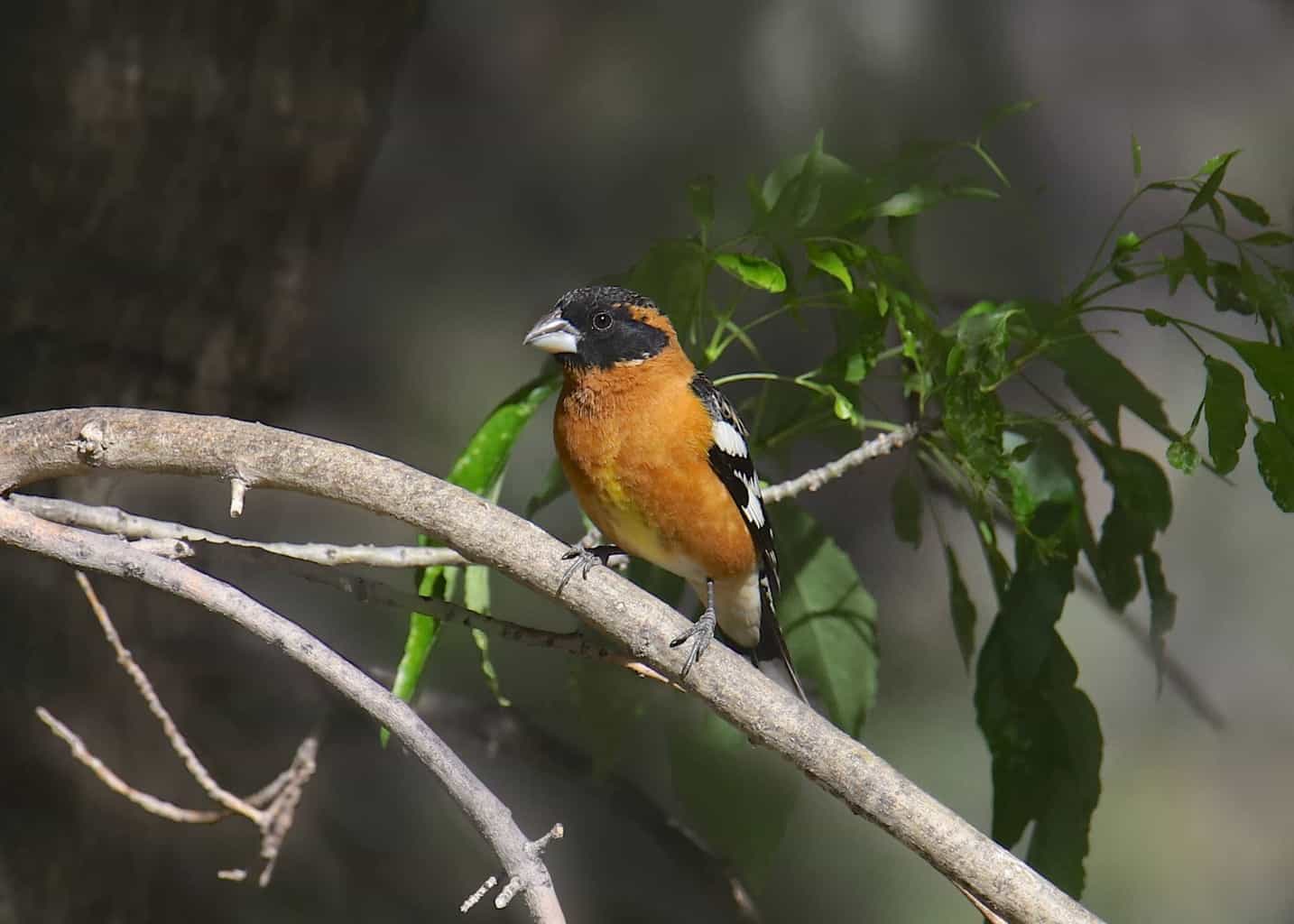
- Scientific Name: Pheucticus melanocephalus
- Length: 5.9 to 7.8 inches
- Weight: 1.3 to 1.7 ounces
- Wingspan: 12.4 to 12.7 inches
Black-headed Grosbeaks are identified by their overall chunky appearance: large, conical bills, thick necks, and short tails. They appear similar to Orioles but stockier.
These hefty songbirds have black heads, orange-cinnamon upperparts, and black-and-white wings. Females have brown above with streaked, warm orange breasts.
They mainly eat seeds, berries, and insects like bees and caterpillars. They also eat Monarch butterflies despite their noxious chemicals.
Black-headed Grosbeaks are primarily found in South Carolina’s riverside woods, streamside groves, and foothills.
Bullock’s Oriole
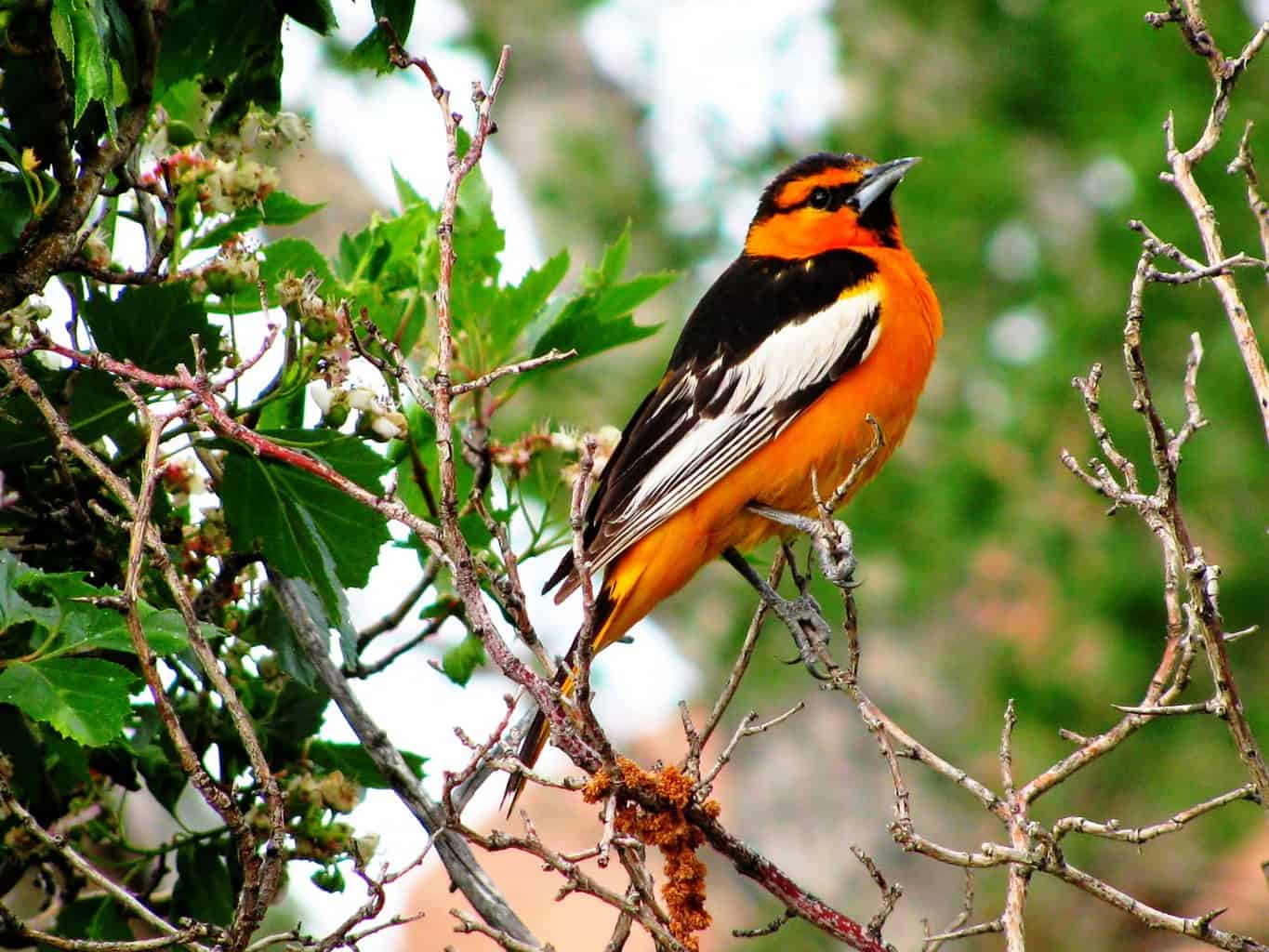
- Scientific name: Icterus bullockii
- Length: 6.7 to 7.5 inches
- Weight: 1.0 to 1.5 ounces
- Wingspan: 12.1 to 12.4 inches
Bullock’s Orioles are gorgeous bright orange songbirds with medium-long tails, sharply pointed bills, and slim but sturdy bodies. Female Bullock’s Orioles have yellowish-orange plumage with mostly gray bellies.
Unlike other songbirds, Bullock’s Orioles dangle upside down from the branches of trees while foraging. They weave remarkable hanging nests using plant fibers, vine tendrils, and strips of bark.
Bullock’s Orioles rarely, if at all, eat from seed feeders. However, they do look for sugary foods in people’s backyards as they complete their spring migration.
If you want to attract Bullock’s Orioles to your garden, consider leaving a half-and-half mixture of water and jelly to imitate syrupy nectar.
Yellow Birds in South Carolina
Bachman’s Warbler
- Scientific Name: Vermivora bachmanii
- Length: 3.9 to 4.3 inches
- Weight: 0.4 to 0.5 ounces
- Wingspan: 4.25 to 4.75 inches
Bachman’s Warblers are among the rarest birds in South Carolina and across the United States.
Unfortunately, this small passerine bird is critically endangered due to the loss of breeding and wintering habitat. Some experts believe that they’re likely already extinct.
Bachman’s Warblers have olive-green upperparts and yellow foreheads, throats, and underparts. They mainly feed on insects and spiders, but some reports state they may have also indulged in nectar.
Yellow-Headed Blackbird
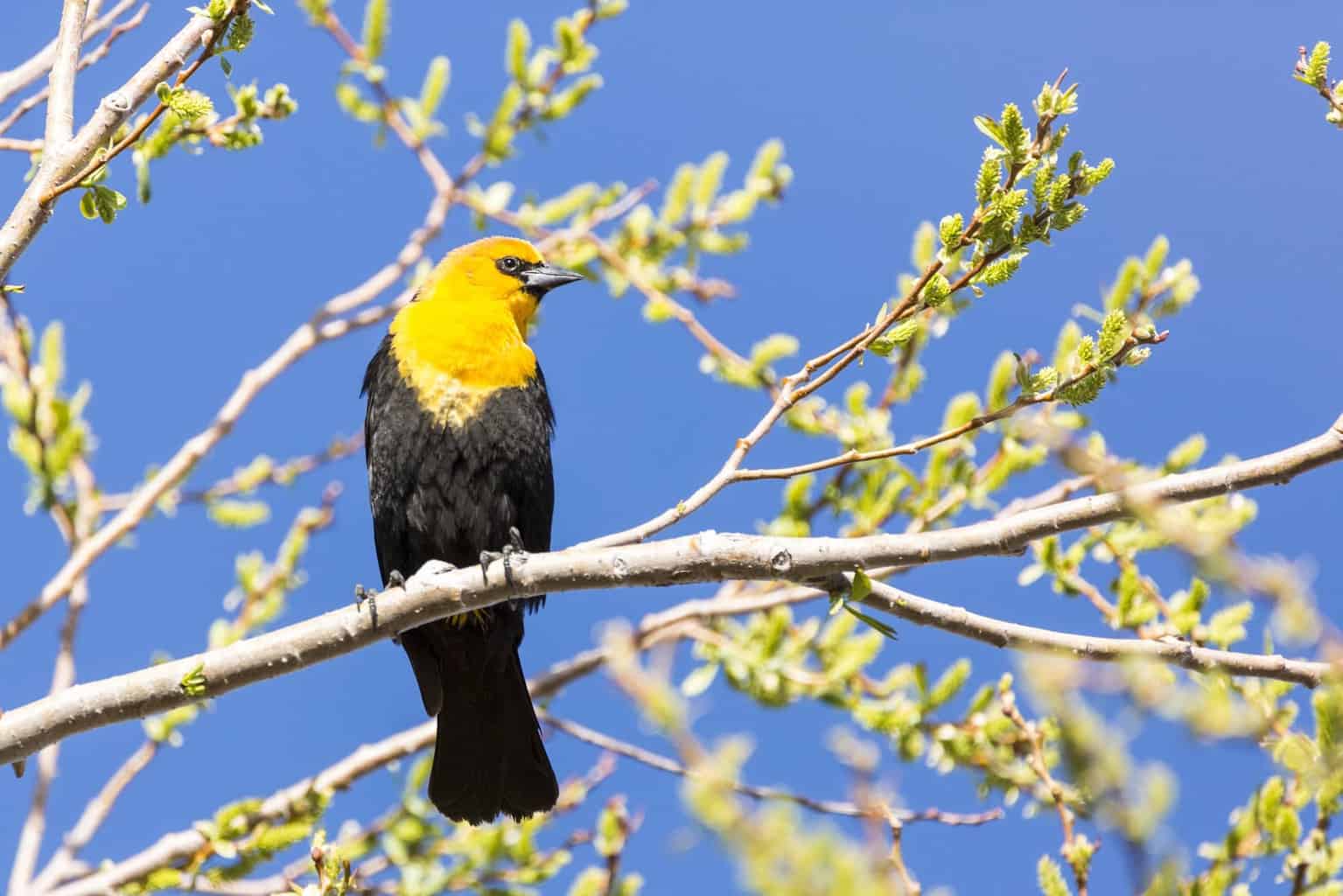
- Scientific Name: Xanthocephalus xanthocephalus
- Length: 8.3 to 10.2 inches
- Weight: 1.6 to 3.5 ounces
- Wingspan: 16.5 to 17.3 inches
As you may have guessed, Yellow-headed Blackbirds have bright yellow heads and primarily black bodies. Their scientific name, Xanthocephalus, literally means “yellow head.”
Although they’re quite a sight to see, they’re less than a pleasure to hear. Many believe that their calls are the worst of any North American bird: harsh, hoarse, scraping.
Yellow-headed Blackbirds are incredibly social birds, joining up by the thousands into large flocks. They’re often seen in crop fields, farmyards, and ranchlands.
These birds nest in the same marshes as Red-winged Blackbirds. Since they’re pretty large, they have no problem displacing smaller birds from prime nesting spots.
Townsend’s Warbler
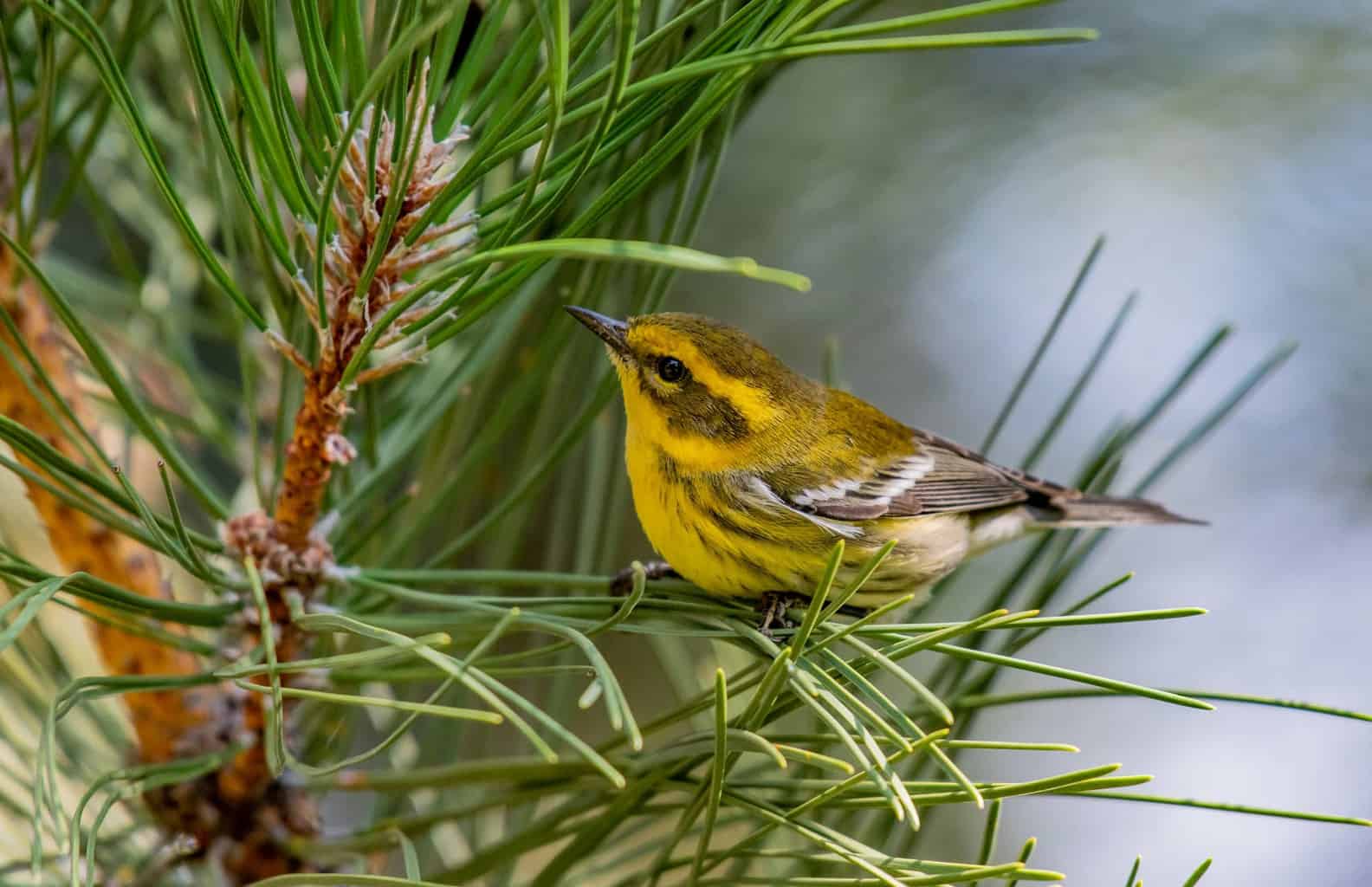
- Scientific Name: Setophaga townsendi
- Length: 4.7 to 5.0 inches
- Weight: 0.3 to 0.4 ounces
- Wingspan: 7.5 to 8.3 inches
The dreamlike, beautiful song of Townsend’s Warblers adds an enchanting aura to any environment. They’re small but lithe, their gorgeous yellow-and-black feathers making them seem like tiny colorful ornaments.
Townsend’s Warblers live in South Carolina’s coniferous forests in humid coastal belts and mountains. They’re found huddling together in mountain forests of oak, pine, and alder when winter comes.
They primarily feed on insects, especially while nesting. They’ll settle on seeds, plant galls, berries, and energy-rich foods like peanut butter from a bird feeding station when food is scarce.
Western Tanager
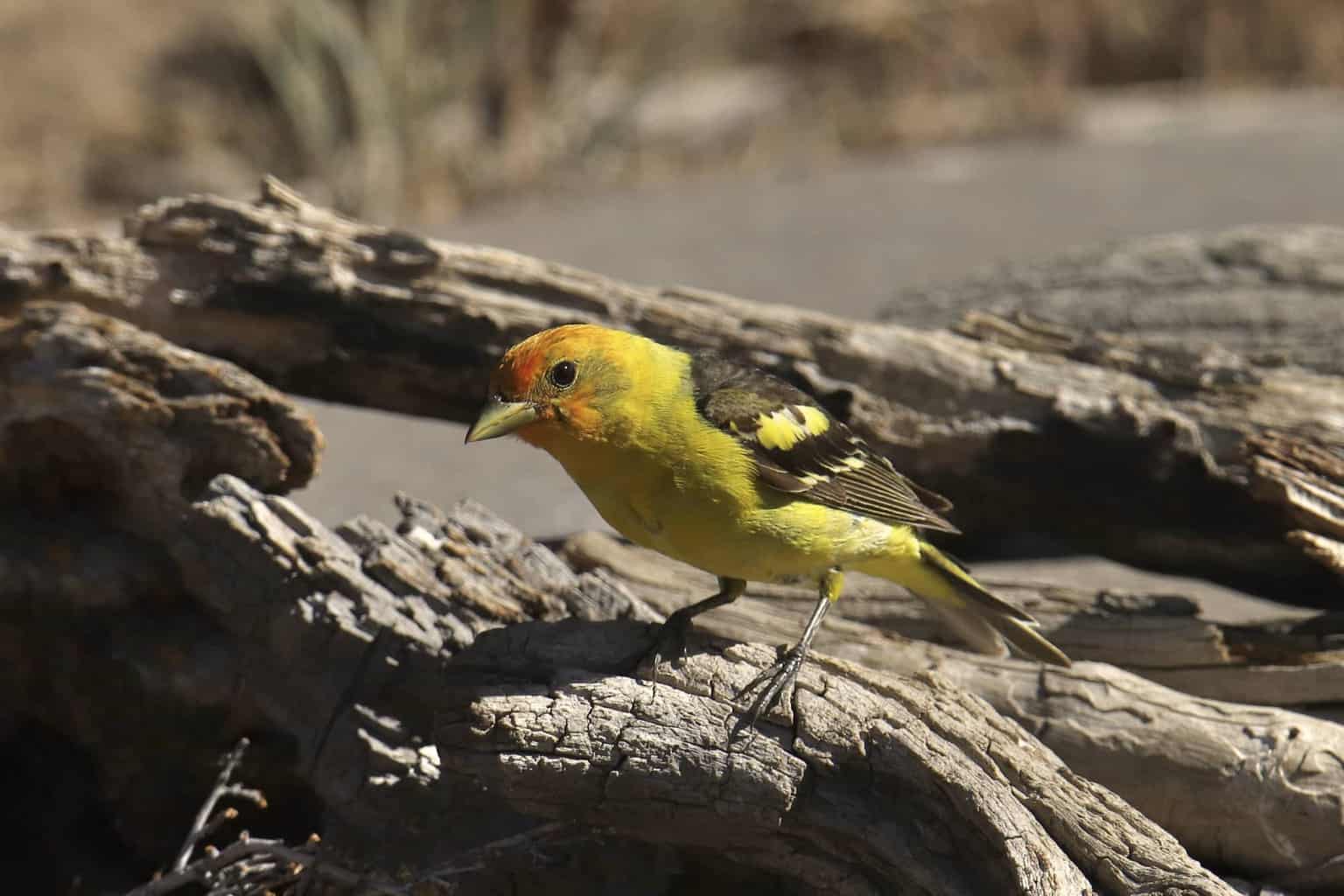
- Scientific Name: Piranga ludoviciana
- Length: 6.3 to 7.5 inches
- Weight: 0.8 to 1.3 ounces
- Wingspan: 11.5 inches
Western Tanagers have brilliant yellow bodies, orange-red heads, and coal-black wings, making them look like a representation of burning fire.
These brightly-colored songbirds mostly live in open conifer or mixed mature forests. They breed in South Carolina’s high mountains, deeply hidden in fir, pine, spruce, and aspen forests.
During migration, you’ll likely find them in nearly every wooded or shrubby habitat.
Western Tanagers catch insects either in mid-air or slowly peering about in foliage. Apart from insects, they also eat fruits—mostly berries—and regularly visit flowers to feed on nectar.
Mourning Warbler
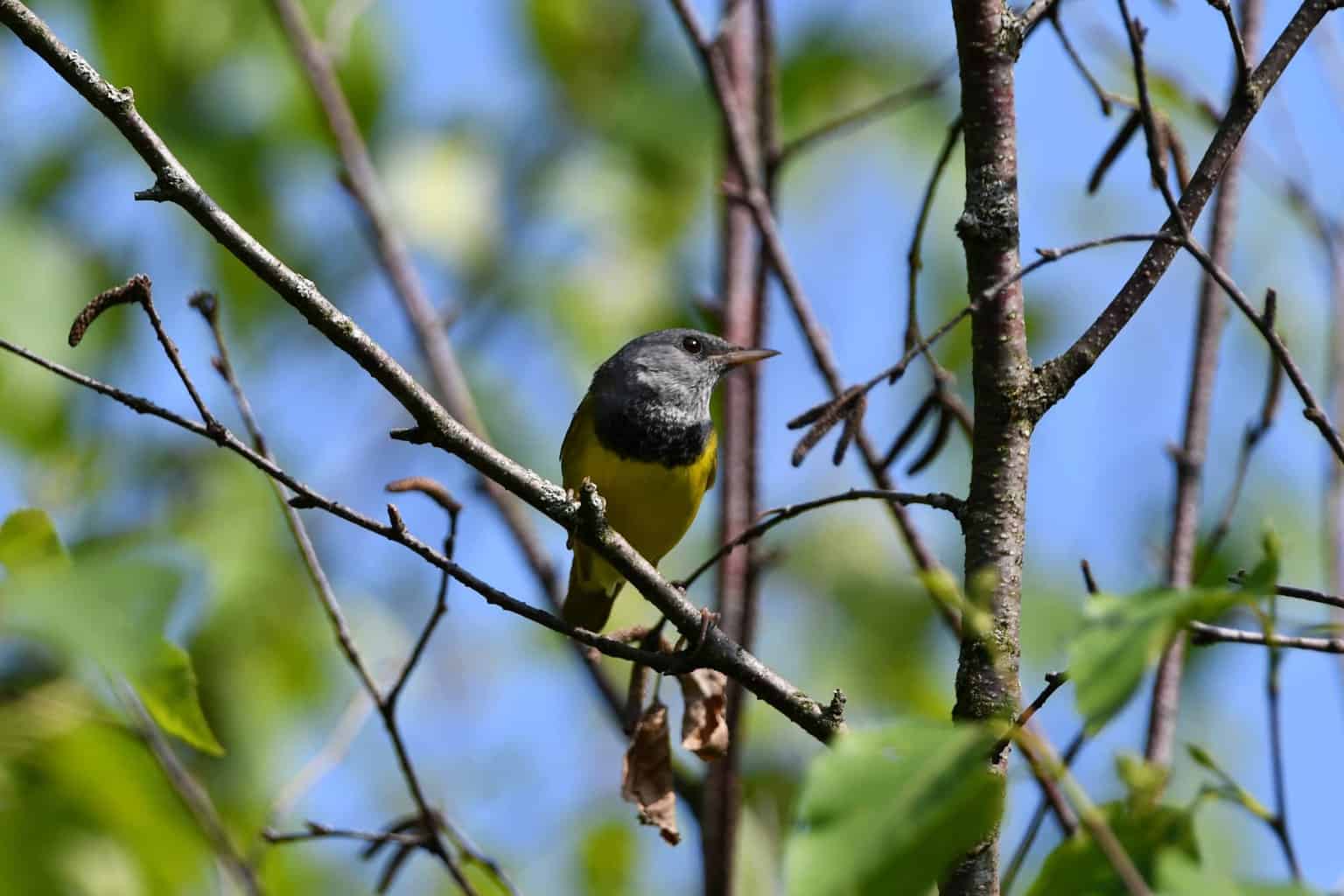
- Scientific Name: Geothlypis Philadelphia
- Length: 3.9 to 5.9 inches
- Weight: 0.5 to 0.6 ounces
- Wingspan: 7 inches
Mourning Warblers are small but steady songbirds with thick necks and plump, full bodies. They look astonishingly similar to Connecticut Warblers, except they have smaller bills.
These warblers are clad in a flattering mix of gray, olive, and yellow, their colors further enhanced by their jewel-like black chest patches.
In South Carolina, Mourning Warblers are common but seldom seen. They’re among the most elusive of all warbler species, content hiding and silently foraging.
These birds are often found in clearings, thickets, undergrowth, and slashings. They mostly live near the ground, foraging in forest understories and low brush, even in between migration periods.
Other Birds To Watch For in South Carolina
Carolina Wren
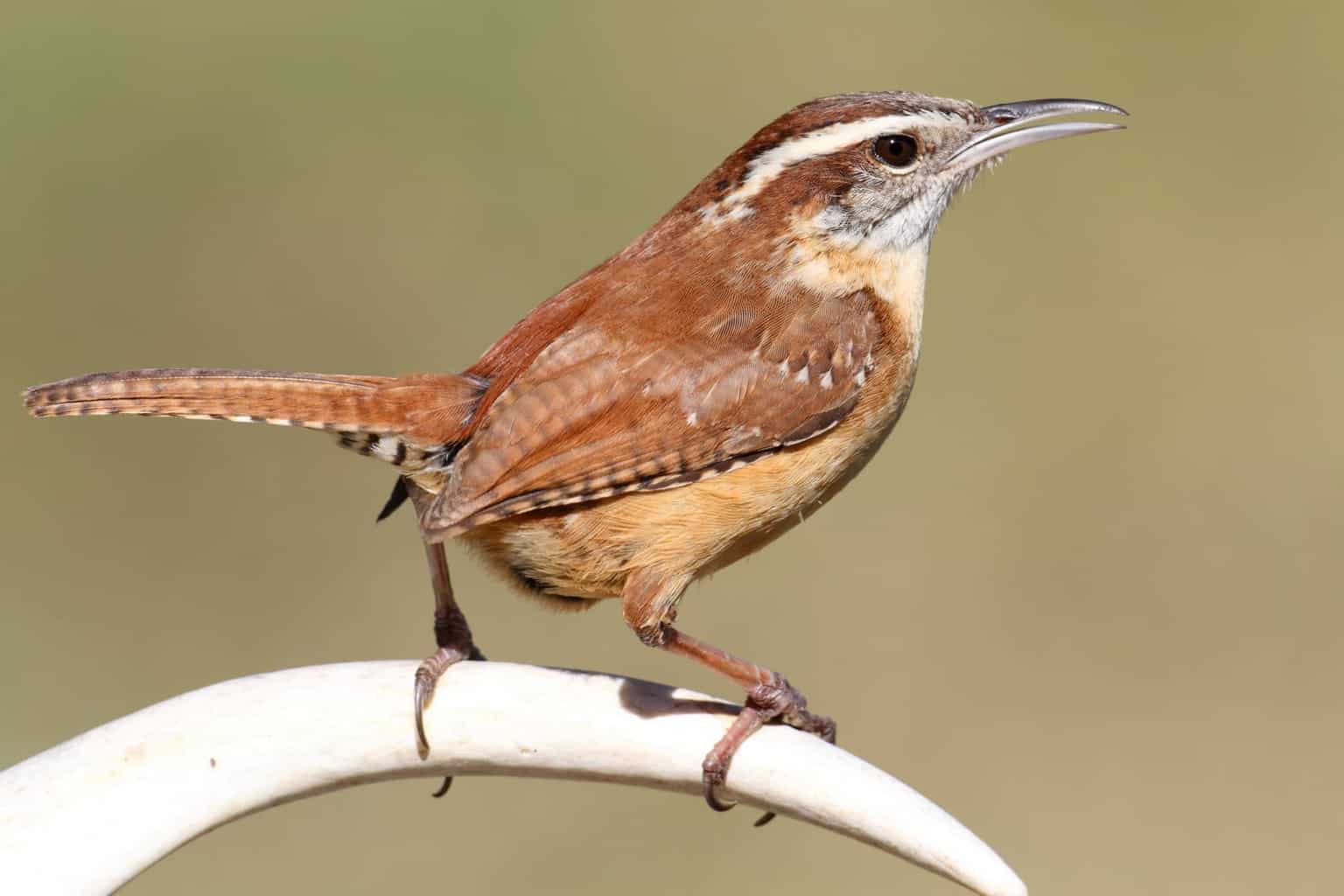
- Scientific Name: Thryothorus ludovicianus
- Length: 4.7 to 5.5 inches
- Weight: 0.5 to 0.8 ounces
- Wingspan: 11.4 inches
While copper-clad Carolina Wrens are widespread throughout the eastern half of the United States, it’s remarkable to see these exuberant birds in South Carolina, where they’re honored as the state bird.
Compared to most wrens, Carolina Wrens are brightly colored. They have unpatterned warm-brown upperparts, buffy-orange underparts, and white chins and throats.
In South Carolina, you can often hear these fabulous birds singing in wooded areas, particularly those with dense vegetation like forest ravines and thickets. They also live in suburban areas with undisturbed low growth and tangles.
Although most wrens are polygamous, Carolina Wrens mate for life. Pairs remain together through thick and thin, from defending permanent territories to caring for their young.
Painted Bunting
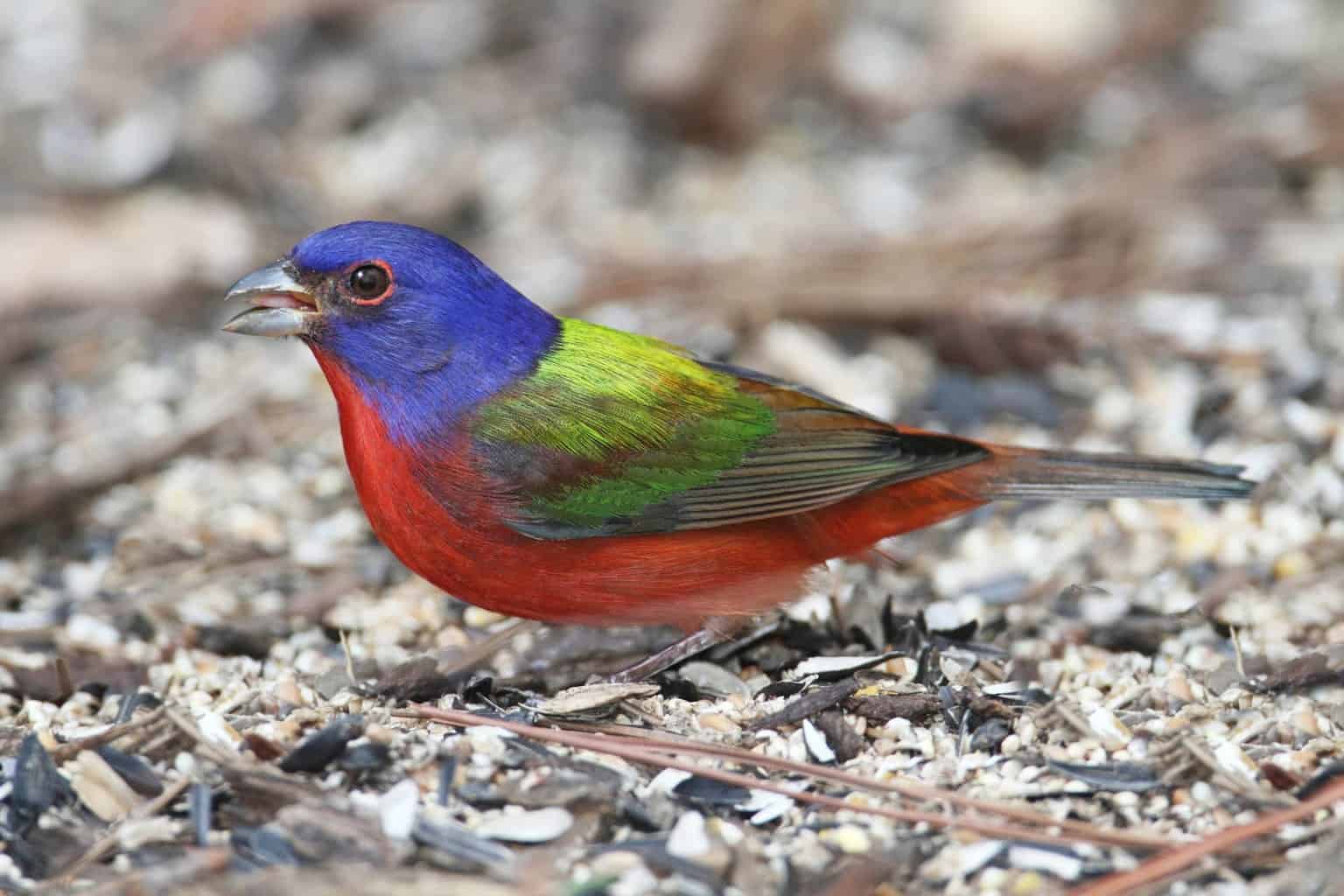
- Scientific Name: Passerina ciris
- Length: 4.7 to 5.1 inches
- Weight: 0.5 to 0.7 ounces
- Wingspan: 8.3 to 9.1 inches
Painted Buntings are perhaps the most colorful songbirds in South Carolina.
Painted Buntings look like they came straight out of a children’s coloring book with splashes of blue, yellow, green, and red. The French call them Nonpareils, meaning “without equal” or “unrivaled,” directly referencing their incomparably beautiful plumage.
Due to their brightly colored feathers, Painted Buntings are often secretive, staying low in thick foliage to avoid being seen by larger predators. Even while high up in dense trees, they sing their bright, warbling songs while partly hidden.
Painted Buntings mainly feed on seeds, primarily those of weeds and grasses. They’ll also sometimes eat berries and fruits, as well as the occasional insect or two.
Carolina Chickadees
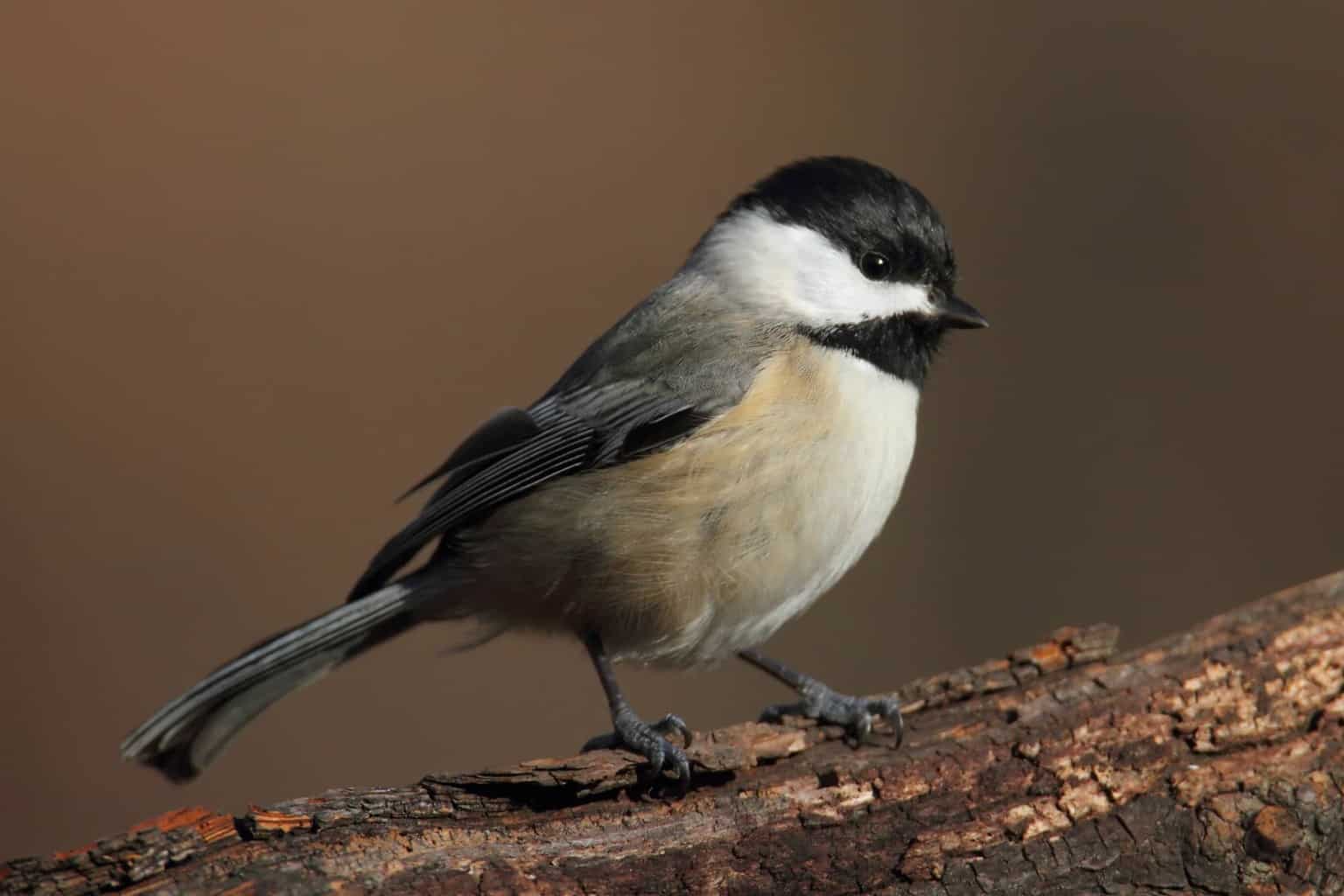
- Scientific Name: Poecile carolinensis
- Length: 4 to 4.7 inches
- Weight: 0.3 to 0.4 ounces
- Wingspan: 5.9 to 8 inches
Carolina Chickadees are the third most common bird species in South Carolina, behind Northern Cardinals and Carolina Wrens consecutively.
These black-and-white birds look astoundingly similar to Black-capped Chickadees: black caps, black bibs, white undersides, and gray wings and back. For this reason, the two birds are often labeled interchangeably.
Carolina Chickadees mostly live in mixed and deciduous forests and river groves. However, they can also be seen in well-wooded parks and suburban yards.
Although they rarely visit bird feeders, Carolina Chickadees may stop by if you own a garden filled with sunflowers and berries.
Tufted Titmouse
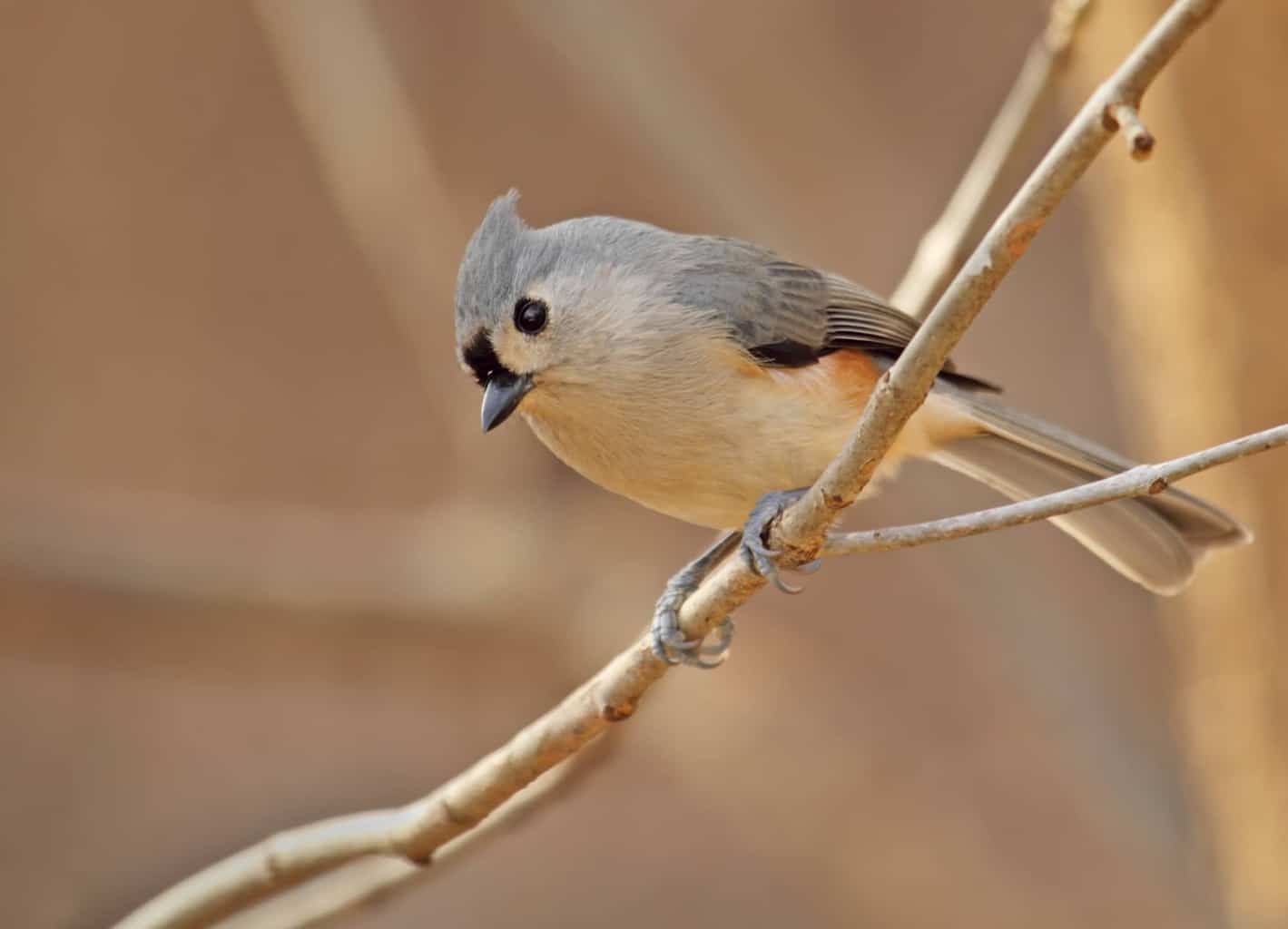
- Scientific Name: Baeolophus bicolor
- Length: 5.5 to 6.3 inches
- Weight: 0.6 to 0.9 ounces
- Wingspan: 8 to 10.2 inches
When compared to other songbirds, Tufted Titmice appear quite large. Their pointed crests, large heads, thick necks, and plump bodies identify them even in silhouette.
Tufted Titmice are common all year in South Carolina, especially in shaded trees, groves, and woodlands below 2,000 feet in elevation. You can also spot them in suburbs, orchards, and city parks with large trees.
These birds mainly feed on different kinds of insects and seeds. When they find large seeds, they’ll carry them to a perch and whack them open with their stout bills.
Final Thoughts
South Carolina’s diverse geography makes it a perfect haven for many birds. With over 400 species, the Palmetto State is a real treat for bird watchers.
Want to know more about some of the country’s most unique species? Check out our list of the most stunning birds in Florida!

